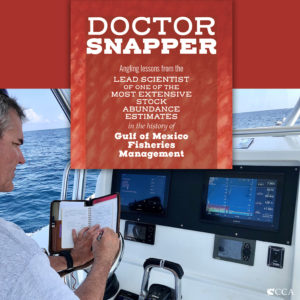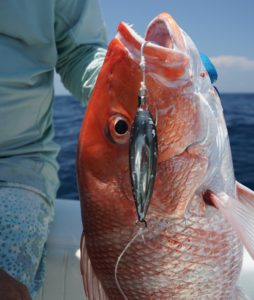

Photo by Pat Murray
Story and Photos by Pat Murray
Dr. Greg Stunz was an expert on Gulf of Mexico red snapper long before he and a team of 22 premier scientists along with their research teams of 80–plus researchers embarked on a 36-month, $12 million, Gulf-wide study of this popular species. Beyond being the Endowed Chair for Fisheries and Ocean Health at Texas A&M Corpus Christi’s Harte Research Institute, the Director of the Center for Sportfishing Science and Conservation, and the current Vice Chairman of the Gulf of Mexico Fishery Management Council, he is also a lifetime inshore and offshore recreational angler. Among his many scientific and angling accolades, he has arguably spent more time catching, tagging, studying, analyzing, searching for and finding red snapper than anyone on the planet.
Having recently completed his important stock abundance assessments for the management of this controversial species, there are many in the fisheries management arena who are very focused on the study’s profound discoveries, the most significant of which is there are a lot more red snapper – three times to be exact – in the Gulf than federal fisheries managers ever acknowledged. As an aside, many in the recreational fishing space have long known and experienced the dramatic the dramatic expansion of this species for years but have largely been ignored in the Council management process. With all of this important data and analysis in the spotlight, it seems like a great moment to step back and ask the scientist / angler what are the best three insights that he gained from this study that anglers can use to improve their next red snapper trip.
The Insight:
We all knew going into the project that large populations of red snapper occur over natural bank outcroppings and artificial reefs, and we showed just that. However, we were astonished to find the vast majority of the red snapper population actually occurs over what we termed ‘Unclassified Bottom.’ Don’t get me wrong, these ‘reef-fish’ were on structured habitat. Surprisingly, we didn’t realize just how much unmarked or unmapped habitat actually occurs in the Gulf of Mexico and the largely unknown population that occurred there. This was great news to find this ‘hidden’ biomass, and it explains why prior stock assessments could not account for the snapper that anglers were seeing on the water. Clearly, those fish have been there the whole time. While these ‘unknown’ features house the vast majority of red snapper in the Gulf, they also include some of the very large ones. These are features such as unmapped natural bottom, exposed oil and gas pipelines, shipwrecks, and many other bottom features.
The Lesson:
Anglers should spend some time finding these out-of-the-way places. Give some thought to areas where unmarked structure might be, like near active platforms that have regular delivery vessels that can accidentally dump gear. Also, known wrecks can sometimes have other debris that stretches away from the main body of the wreck itself. Scan the area for structure and you may be rewarded with some very large red snapper.
The Insight:
This study definitively showed that red snapper have become so abundant that they are very easy to catch over most offshore structures.
The Lesson:
Make it easy on yourself. Ditch the dead bait and use jigs. Jigs tend to catch larger fish, generally provide a clean and easy technique, and if you’ve never experienced a snapper slamming a jig, literally hang on, you’re going to experience an incredible bite. The Shimano Flat Fall and Butterfly jigs are my favorite. They get down to the structure quickly, and snapper love them. The trick is to drop the jig to the bottom and very quickly reel the lure toward the surface while making sharp jerks and drops with your rod tip, almost like you’re repeatedly, aggressively, setting the hook. You will not have to question what it feels like when one hits…trust me…you will know.
The Insight:
Red Snapper are very structure-oriented and for the most part stay put. Based on our electronic tagging, other than gradual movements over time or disturbance during strong storm, red snapper will stay on a structure for years at a time.
The Lesson:
Once you find some good, off-the-beaten-path structure, save and guard that spot. It could produce for years.
Conservation Note from Dr. Stunz:
Of the many things this study showed, it demonstrated that anglers can easily practice catch-and-release for deep-water fish using descender devices such as a SeaQualizer. With previously unthinkably high return rates on tagged fish, the study clearly showed that descender devices work. Anglers have always been the best and wisest stewards of the resource, and these devices are an important part of deepwater conservation. Visit the HRI / CCA / Shimano ReleaSense program website at releasense.org for more details on how to use these devices and many other catch-and-release strategies to ensure your fish survive to be caught another day.








